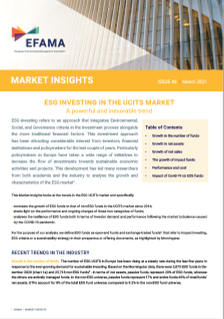The report looks at the major trends in the ESG UCITS market, the impact of the coronavirus pandemic, and the behaviour of ESG and non-ESG funds.
Tanguy van de Werve, EFAMA Director General commented: “Our new Market Insights shows that the ESG market has quite possibly reached a turning point in 2020. New regulatory measures, such as the Sustainable Finance Disclosure Regulation that came into force yesterday, intend to enhance comparability and trust for investors in ESG funds, as well as hold market participants accountable and avoid greenwashing. Promoting confidence in this market can increase participation, especially from retail investors, thereby further accelerating the trend we observe. It is crucial that the investment management industry continues to engage with policymakers to ensure the development and implementation of regulations and standards that enable market participants to fully contribute to the ESG agenda”.
The full report includes the following highlights:
-
ESG funds - The number of ESG funds grew at more than double the rate of non-ESG funds during the past five years, with a significant acceleration since 2017. Equity and bond ESG fund assets increased by 197% and 181%, respectively, in this period. This growth reflects both the creation of new funds and the integration of ESG criteria into the investment process of existing funds.
-
Net assets and net sales - ESG funds saw their assets increasing by 37.1% in 2020 to reach EUR 1.2 trillion at end-December. Net sales of ESG funds grew from EUR 19.5 billion in 2016 to EUR 235 billion in 2020.
-
Passive vs. active funds - Passive funds represent 20% of net assets held in the total ESG fund universe, while 80% of assets are actively managed. Reflecting a similar balance, 17% of funds in the non-ESG fund universe are passively managed and 83% are actively managed funds. ETFs account for 8% of the total ESG fund universe, compared to 9.2% in non-ESG.
-
Asset classes - Equity funds dominate the ESG space, representing 56% of the fund universe at the end of December 2020 compared to 39% within non-ESG funds.
-
E, S or G? - Environmental funds dominate the impact fund category, with funds focusing on low carbon emissions being the most dominant category (55%) and renewable energy funds exhibiting the highest growth (604%) since 2016. During the same period, social funds experienced substantial growth in demand (340%), highlighting the growing popularity of social topics in sustainable investing.
-
Performance - The performance of ESG and non-ESG funds has been broadly similar since 2016, the exception being 2020 when ESG equity and bond funds recorded a higher average gross performance. This finding confirms that, on average, investors do not have to sacrifice long-term returns to support the transition to a more sustainable economy. Equally important, the report shows that the differences between the performance of the top and bottom ESG and non-ESG funds are quite large, reflecting the fact that the universe of funds is made up of many different funds in terms of investment strategy.
-
Cost - ESG funds, on average, tend to be slightly cheaper than non-ESG funds. This situation can be explained by the fact that many ESG funds have been launched recently in the context of stiff competition among fund managers, who also have a strong incentive to limit ongoing charges to attract investors. The report also highlights a downward trend in the cost of both ESG and non-ESG funds.
Vera Jotanovic, senior economist at EFAMA, commented: “The ESG funds universe has been growing rapidly since 2016, in parallel with the awareness of the importance of the sustainability agenda. The development of ESG funds has become a priority for many in the industry and their resilience during last year’s Covid-induced market stress has contributed to further accelerating the growth trend.”



























